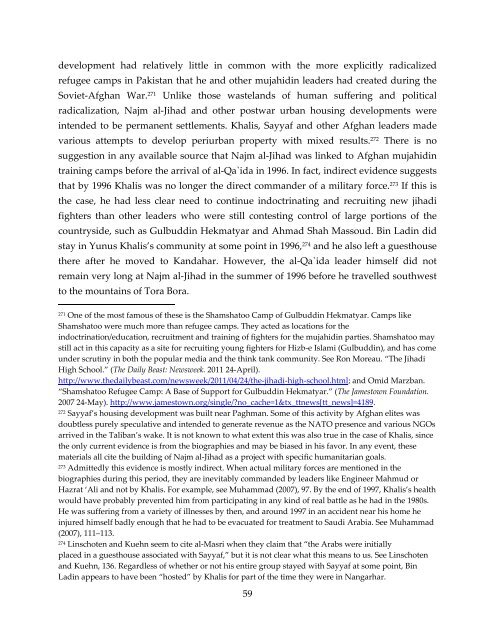Usama bin Ladin’s “Father Sheikh”:
Usama bin Ladin’s “Father Sheikh”:
Usama bin Ladin’s “Father Sheikh”:
You also want an ePaper? Increase the reach of your titles
YUMPU automatically turns print PDFs into web optimized ePapers that Google loves.
development had relatively little in common with the more explicitly radicalized<br />
refugee camps in Pakistan that he and other mujahidin leaders had created during the<br />
Soviet‐Afghan War. 271 Unlike those wastelands of human suffering and political<br />
radicalization, Najm al‐Jihad and other postwar urban housing developments were<br />
intended to be permanent settlements. Khalis, Sayyaf and other Afghan leaders made<br />
various attempts to develop periurban property with mixed results. 272 There is no<br />
suggestion in any available source that Najm al‐Jihad was linked to Afghan mujahidin<br />
training camps before the arrival of al‐Qa`ida in 1996. In fact, indirect evidence suggests<br />
that by 1996 Khalis was no longer the direct commander of a military force. 273 If this is<br />
the case, he had less clear need to continue indoctrinating and recruiting new jihadi<br />
fighters than other leaders who were still contesting control of large portions of the<br />
countryside, such as Gulbuddin Hekmatyar and Ahmad Shah Massoud. Bin Ladin did<br />
stay in Yunus Khalis’s community at some point in 1996, 274 and he also left a guesthouse<br />
there after he moved to Kandahar. However, the al‐Qa`ida leader himself did not<br />
remain very long at Najm al‐Jihad in the summer of 1996 before he travelled southwest<br />
to the mountains of Tora Bora.<br />
271 One of the most famous of these is the Shamshatoo Camp of Gulbuddin Hekmatyar. Camps like<br />
Shamshatoo were much more than refugee camps. They acted as locations for the<br />
indoctrination/education, recruitment and training of fighters for the mujahidin parties. Shamshatoo may<br />
still act in this capacity as a site for recruiting young fighters for Hizb‐e Islami (Gulbuddin), and has come<br />
under scrutiny in both the popular media and the think tank community. See Ron Moreau. “The Jihadi<br />
High School.” (The Daily Beast: Newsweek. 2011 24‐April).<br />
http://www.thedailybeast.com/newsweek/2011/04/24/the‐jihadi‐high‐school.html; and Omid Marzban.<br />
“Shamshatoo Refugee Camp: A Base of Support for Gulbuddin Hekmatyar.” (The Jamestown Foundation.<br />
2007 24‐May). http://www.jamestown.org/single/?no_cache=1&tx_ttnews[tt_news]=4189.<br />
272 Sayyaf’s housing development was built near Paghman. Some of this activity by Afghan elites was<br />
doubtless purely speculative and intended to generate revenue as the NATO presence and various NGOs<br />
arrived in the Taliban’s wake. It is not known to what extent this was also true in the case of Khalis, since<br />
the only current evidence is from the biographies and may be biased in his favor. In any event, these<br />
materials all cite the building of Najm al‐Jihad as a project with specific humanitarian goals.<br />
273 Admittedly this evidence is mostly indirect. When actual military forces are mentioned in the<br />
biographies during this period, they are inevitably commanded by leaders like Engineer Mahmud or<br />
Hazrat ‘Ali and not by Khalis. For example, see Muhammad (2007), 97. By the end of 1997, Khalis’s health<br />
would have probably prevented him from participating in any kind of real battle as he had in the 1980s.<br />
He was suffering from a variety of illnesses by then, and around 1997 in an accident near his home he<br />
injured himself badly enough that he had to be evacuated for treatment to Saudi Arabia. See Muhammad<br />
(2007), 111–113.<br />
274 Linschoten and Kuehn seem to cite al‐Masri when they claim that “the Arabs were initially<br />
placed in a guesthouse associated with Sayyaf,” but it is not clear what this means to us. See Linschoten<br />
and Kuehn, 136. Regardless of whether or not his entire group stayed with Sayyaf at some point, Bin<br />
Ladin appears to have been “hosted” by Khalis for part of the time they were in Nangarhar.<br />
59


